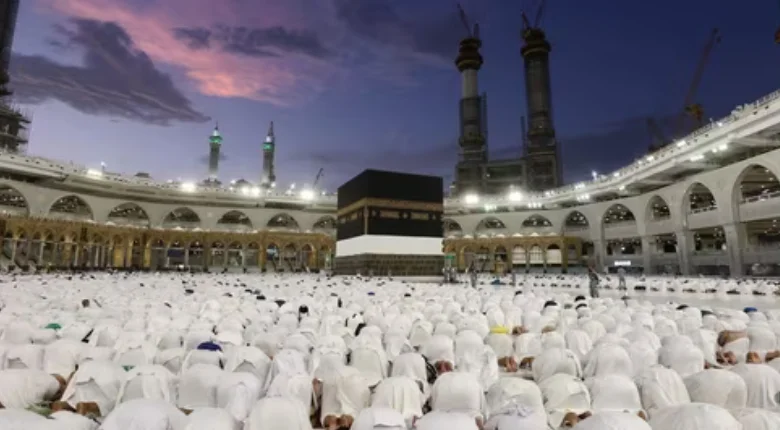Hajj 2023: Date, history And significance

Introduction of Hajj:
Things you will learn in this blog
- What is a hajj and its importance?
- History of hajj and kabaa?
- How hajj was started?
- The well of Zam Zam
- Who did the Construction of Kabaa?
- Who is allowed to go on Hajj?
- The five core beliefs of Islam?
What is Hajj?
Every year, millions of Muslims from all over the world take part in Hajj, which is the fifth pillar of Islam and a sacred pilgrimage.
During the Holy month of Zul Hajah, which is the 12th month on the Islamic calendar, Hajj takes place in Makkah, situated in Saudi Arabia.
Hajj is a spiritual duty and a pillar of Islam. This means that every Muslim must do Hajj at least once in their lives if they are able to do so financially, and physically. If you really want to please Allah (SWT) “The Most Glorified, The Highest,” you can go more than once in your lifetime.
Preparing for Hajj is a very exciting and spiritually important time for anyone. For a Muslim, going to Hajj for the first time can be a once-in-a-lifetime event.
The Hajj is a spiritual, mental, and physical test of patience and temperament. But it gives Muslims a chance to renew themselves spiritually, get rid of their mistakes, and get closer to Allah (SWT).
Hajj happens between the 8th and 12th of zul Hajah every year. Muslims use a calendar based on the moon, so the Gregorian date that goes with it will change from year to year.
This is an easy-to-use and detailed Hajj guide we’ll help you learn about the holy journey, from where it came from to how to do it.
The Hajj Procedure Step by Step:-
- Planning and Intention
- Enter Ihram’s state
- 7 Tawaf
- Safa and Marwa
- Hair clipping/shaving (Umrah ends)
- Praying and resting
- Make your way to Mina
- Arafah’s Day
- Muzdalifah (under the stars)
- Rami (the devil’s stoning)
- Hady
- Eid al-Adha and Qurbani
- The Head Shaving
- Tawaf al Ifadha
- Saai’
- Spend the night in Mina
- Tawaf al-Wida, farewell.
Around 2.5 million pilgrims arrived in Baitullah to perform Hajj in 2019, Hajj in Mecca (Saudi Arabia) is considered the world’s greatest human gathering. So, if you’re one among the pilgrims traveling to Saudi Arabia to complete this holy ritual, or you want to know more deeply about the hajj keep reading!
We’ve put up this helpful step-by-step Hajj guide to assist you on your wonderful journey!
When Do Muslims Perform Hajj?
Muslims use the lunar calendar (rather than the Gregorian calendar) in Islamic tradition, and Hajj occurs each year between the 8th and 12th of zil Hajj. However, the equivalent Gregorian dates vary from year to year since the lunar calendar appears to move forward 11-12 days. Hajj pilgrims now travel to Makkah via land, air, and sea in the days and weeks leading up to the pilgrimage period. You will fly to Makkah with your Hajj group.
Main Types Of Hajj.
- Tamattu,
- Ifraad,
- Qiran
These are the three types of Hajj.
For the sake of this Hajj guide, we shall use the Tamattu type of Hajj, which was preferred by the Holy Prophet Muhammad (peace and blessings be upon him). The following are the detailed steps of Hajj:
Planning and Intention: –
It is essential to make your intention (niyyah) within your heart before arriving in Makkah to commence Hajj. The purpose must be to complete the Hajj only for Allah’s sake, with an expectation for good in the afterlife. It should not be carried out with the purpose of being noticed by others or for financial reward.
Entering the Ihram State: –
you will enter the state of Ihram (ritual purity) For men, this entails donning the designated white fabric and wrapping one piece around your shoulder and the other around your waist. Ladies are free to wear whatever they choose as long as they follow the Hijab guidelines, on the other hand, Face coverings are not allowed.
Shoes that cover the entire foot are similarly not permitted. Both men and women must wear sandals as their footwear. Ihram is the spiritual state that you enter, once you have decided to perform Hajj. When nearly 2.5 million pilgrims arrive in Makkah, there should be no visible distinction between them. Everyone is equal before Allah (SWT), regardless of class, color, society, or income.
The standards governing Ihram dress are exceedingly simple, yet strict, and must be followed. We should be especially watchful of our attitude and words during these holy days when we’re in the state of Ihram. We should refrain from smoking, having sexual relations, cursing, shaving our hair, and cutting our nails. We must also refrain from using perfume or scented soaps.
With these preparations in mind, you’ll be ready to start on the most important spiritual journey of your life when you arrive at the sacred Masjid al-Haram in Makkah!
Note: Carry spare Ihram garments if possible. When it comes to footwear, we recommend investing in a good pair of trekking sandals. Given that you will be walking long distances on both tarmac and dirt, these sandals are usually the most comfortable and practical. Try to break in your sandals before leaving for Saudi Arabia so you don’t experience discomfort.
When you arrive in Makkah, you must first do your Umrah, which includes your Tawaf and Sai as stated in the following procedures.
7 times Tawaf:-
Tawaf is one of the pilgrimage’s main rites, and it involves walking in anti-clockwise cycles around the Kaa’bah. One Tawaf is made up of seven complete rounds, each of which begins and ends at the black stone located within the Kaa’bah. In addition to your Tawaf, you may offer voluntary prayers to thank Allah (SWT) for your safe arrival and to honor the beginning of this incredible spiritual journey.
After you’ve completed your Tawaf, you’ll proceed to Sa’i (walking and running between the two hills of Safa and Marwa). You’ll start the Sa’i on Safa Hill and trek towards Marwa Hill. When you see the green marker, sprint until you reach the next green marker and continue walking till you reach Marwa. This brings us to the end of one lap. After then, you’ll return to Safa to finish your second lap.
Your Sa’i is complete when you have completed seven loops between the hills of Safa and Marwa. This is a significant rite commemorating Prophet Ibrahim’s (AS) wife bibi Hajara (sa) and her struggle in the desert to find water for her son Prophet Isma’il (AS). Sa’i represents the struggle Bibi Hajara faced throughout her life.
Hair (Umrah Ends): Clip/Shave:
Men will have their hair clipped or shaved once Sa’i is finished, while women will have their hair cropped to the length of their fingertips. This completes your umrah and allows you to depart Ihram till the 8th of Dhul Hijjah. Tip: Be patient in this situation. You’ll be exhausted from tawaf, and you may notice other pilgrims rushing to finish the Sa’i. You are free to take your time.
Take frequent rests and drink the Zam Zam water accessible between Safa and Marwa. Take a break and pray Now that you’ve completed your Umrah, you’ll spend the rest of this glorious month in Makkah finishing your spiritual journey of Hajj, accompanied by your fellow Muslim sisters and brothers,
Make the most of your time by practicing genuine acts of worship and getting enough rest. On the 8th of Zil Hajj, your Hajj will begin. Returning to Ihram (Day 1 / 8th Zil Hajj) Insha’Allah (God willing), fulfilling your sacred responsibility of Hajj will be the most spiritual period of your life, filled with blessings and pardon from Allah Almighty (SWT)! The eighth day of Zil Hajj marks the start of Hajj and the next part of your spiritual journey. You will purify yourself and return to Ihram.
Ihram Procedures It is critical to note that while in Ihram, you are not permitted to smoke, swear, shave, clip your nails, or engage in any form of sexual relations. Fighting and arguments are also prohibited, as are hunting, killing, or unjustifiably breaking anything.
You should also avoid using scented goods like perfumes, moisturizers, cosmetics, or soaps. You may, however, substitute unscented products that are legal to use. When you’re ready to enter the Ihram, begin reciting the Talbiyah, which is the following invocation:
لَبَّيْكَ اللَّهُمَّ لَبَّيْكَ، لَبَّيْكَ لاَ شَرِيْكَ لَكَ لَبَّيْكَ، إِنَّ الْحَمْدَ وَالنِّعْمَةَ لَكَ وَالْمُلْكَ لاَشَرِيْكَ لَكَ
Transliteration: Labayk Allah huma Labayk ,Labayk la shareeka lakalabayk ,Inal hamda wanneymata Laka wal mulk La shareekala.
You will then travel with your Hajj qafila to the Makkah suburb of Mina, which is around eight kilometers outside the city center. We recommend bringing some essentials with you, such as unscented sun cream, moisturizer, Vaseline, and soap.
Sun cream is especially useful if you have no hair, as men are not permitted to cover their heads or faces while in ihram. Vaseline is also very useful for both men and women in preventing unpleasant rashes caused by prolonged walking. In Saudi Arabia, all of these are widely available.
Arrival in Mina When you arrive in Mina’s tent city (neighborhood), you will settle into your assigned tent. You will pray Salah (obligatory prayers) here, including Zohar, Asr, Maghrib, ‘Isha, and Fajr, reducing your four-unit prayers to two units each, as indicated in the Qu’ran.
You’ll spend the night praying to Allah (SWT), reading the Qur’an, and getting ready for the next day. This is a significant time for spiritual thoughts and devotion, so make the most of it. Tip: Be patient here, since space inside the tents can be limited, and you may find yourself in close quarters with other pilgrims. Because the weather is expected to be quite hot, remember to stay hydrated.
The Saudi authorities have placed cold water stations near all tents, so get familiar with your surroundings. You may also notice that Hajj authority staff stocks complimentary cold drinks in cooler boxes adjacent to your tent on a frequent basis, these are for you to drink, so enjoy them to quench your thirst, but don’t lose sight of the spiritual reason for your visit. ‘Arafah Day (Day 2 / 9th Zil Hajj)
After sunrise in Mina, you’ll travel to the plains of ‘Arafah, where you’ll recite Astaghfar (asking for forgiveness) and make supplications, commemorating the Day of ‘Arafah, when we seek Allah Almighty (SWT) for the forgiveness of our misdeeds. When pilgrims reach the plains of Mount ‘Arafah, they witness shorter zohar and Asar prayers (two rakat instead of four).
A sermon will be delivered from Masjid al-Nimra on Mount ‘Arafah on this day. If feasible, try to listen to the Khutbah (sermon). Your group could potentially help with an English translation of this sermon.
Allah Almighty (SWT) refers to the Day of ‘Arafah in Surah al Maidah as the Day on which He excepted this religion, completed His favors upon His beloved Holy Prophet Muhammad (peace and blessings be upon him), and approved Islam as a Deen!
So, stand on the plains of ‘Arafah and make lots of Du’a (supplication), focusing your efforts towards Allah Almighty (SWT) and asking Him for forgiveness and blessings for you and your family. Remember to involve your friends, relatives, neighbors, and the entire Ummah (community) in your Du’a on this wonderful day. On this day, avoid exhausting your energy by trekking up Mount ‘Arafah, also known as Jabal al-Rahmah.
The hill from where the Holy Prophet Muhammad (peace and blessings be upon him) gave his sermon is known as Jabal al-Rahmah. There is no credible source that claims there is any benefit to walking the hill or performing this journey as a religious ritual.
The level area surrounding the hill is known as the Plains of ‘Arafah, and it is here that you should spend your time in prayers. When you arrive at Muzdalifah, You’ll leave ‘Arafah after dusk and travel to Muzdalifah, an open plain between Mina and ‘Arafah. When you get to Muzdalifah, recite Maghrib and ‘Isha Salah one after the other, reducing the ‘Isha Salah to two Rakat.
According to Abdullah ibn Umar (RA): “The Holy Prophet (peace and blessings be upon him) offered the Maghrib and ‘Isha prayers at Muzdalifah together with a separate Iqamah (second call to prayer) for each of them and did not offer any optional prayer in between or after each of them.”
After that, you can spend the night worshipping or sleeping. The Holy Prophet (peace and blessings be upon him) slept until shortly before Fajr, instead of engaging in night worship as he usually did. So, instead of exhausting yourself, rest – you have a full day ahead of you! You can also collect pebbles in Muzdalifah to conduct Rami (the stoning of the devil) over the next three days.
The pebbles should be roughly the same size as date stones/seeds. You’ll need 49 pebbles in total. However, it is recommended that you collect an additional 21 pebbles as a preventive measure, bringing your total to 70. You may miss the target or have some stones fall from your hand as you progress through the steps of tossing the pebbles at the Jamarat (the stone pillars). As a result, having more is preferable over being short. Pebbles can also be found at any place in Mina.
At Muzdalifah, you will sleep under the stars.
There are no tents or other forms of lodging available here. Despite the numerous lights, it is still quite dark. Stay close to your group, as it is quite easy to become disoriented amid the thousands of pilgrims. Muzdalifah has toilets and Wuzu facilities, however, they are likely to be packed, therefore patience is required. We strongly advise you to use the restrooms and clean up before leaving ‘Arafah.
Rami and Hady (Day 3 / 10th zil Hajj / Eid al-Adha Begin)
The 10th of Dhul Hijjah is also known as Yawm al-Nahr or Qurbani (Day of Sacrifice). After performing Fajr Salah, you will leave Muzdalifah and return to Mina. Remember to repeat the Talbiyah continually. Pilgrims execute the Hady (sacrificial animal) and begin the first of three days of the’stoning of the demon’ ceremony, or Rami, on this day.
During this time, Muslims all over the world perform Qurbani and begin the four-day Eid al-Adha festival. This is evident from the following verse in the Qur’an: “And when you are safe, whoever performs Umrah in addition to Hajj shall make an offering of whatever animal is available.” Anyone who finds none must fast for three days during Hajj and seven days after your return, for a total of 10 days. This is for him; whose family members do not live at Al-Masjid-ul-Harm.” Qur’an | 2:196
Rami’s Origin (The Devil’s Stoning)
The stoning of the Jamarat, also known as the “stoning of the devil,” is a Hajj pilgrim ceremony in which pebbles are thrown at three stone buildings in Mina over three days. The first day of stoning is on zil Hajj 10th. Muslims also perform Qurbani and celebrate Eid al-Adha on this day. Rami is the act of throwing stones at the Jamarat.
The Rami ritual represents Hazrat Ibrahim’s (AS) deeds when he faced the trial of having to sacrifice his son, Hazrat Isma’il (AS), at Allah’s (SWT) order. Iblis (Satan) frequently sought to entice Hazrat Ibrahim (AS) to disobey Allah (SWT) on the road to carrying out the mandate.
When Hazrat Ibrahim (AS) arrived in Jamarat al-Aqaba, Allah (SWT) directed an Angel Jibreel (AS) to tell Hazrat Ibrahim (AS) and order him to throw seven stones at Iblis. He complied, and Iblis instantly fled. The three Jamarat represent the three locations where Iblis attempted to persuade Hazrat Ibrahim (AS) not to fulfill Allah’s instructions.
How To Carry Out The Rami (The Devil’s Stoning)
You shall execute Rami (the stoning of the demon) on the 10th, 11th, and 12th days of Zil Hajj. The pebbles should be roughly the size of date stones or seeds. You’ll need 49 pebbles in total. Each of the three days will require a different number of stones. Here’s how it breaks down: 7 stones for Zil Hajj 10th For the 11th of Zil Hajj, 21 pebbles For the 12th of Zil Hajj, 21 pebbles Carry four little pockets for your pebbles per person.
Sort the pebbles into the four pouches according to the breakdown above. When you get to the Jamarat, go to the largest pillar, Jamarat al-Aqaba, and toss the first seven pebbles at the concrete pillar. On the first day, you will only hit this one pillar. You will say Takbir after each throw: “اللهُ أَكْبَرُ” Transliteration: “Allhu ‘Akbar” means “God is Great.”
Tip: Don’t rush through the Rami. The Hajj authority will most likely set aside a specific period for your group to perform Rami. They do this to reduce overcrowding and pilgrim risk. Try not to become enraged and throw your sandals or other valuables at the pillars. Because Iblis is not contained within the pillar, you will just lose your goods and gain nothing!
Eid al-Azha and Qurbani
On this day, Muslims around the world who are not on pilgrimage on the 10th Zil Hajj commemorate Eid al-Azha or the Feast of Sacrifice. Muslims commemorate Prophet Ibrahim’s (AS) readiness to sacrifice his son Hazrat Isma’il (AS) at Allah’s (SWT) command by performing Qurbani (sacrifice).
Shaving the Head (11th Dhul Hijjah, Day 4)
If you are male, you will shave or trim your hair after offering the Hady. A lady cuts her hair to the length of a fingertip. You are now permitted to leave Ihram and wear comfortable attire. Except for sexual intimacy, you are also permitted to resume other Halal activities that were prohibited during Ihram.
As the Holy Prophet Muhammad (peace and blessings be upon him) is scented strongly of musk at this point, it is Sunnah (the practice of the Prophet PBUH) to apply perfume. Use disposable razors to shave each other’s heads in your group. If that isn’t possible, there are a number of barbers in Mina who will shave your head for a fee. To avoid infection, make sure the barbers use new blades.
Tawaf al-Ifadha and Saai’ (Dhul Hijjah 5, 12th)
You will now go to Makkah for Tawaf al-Ifadha, followed by another round of Saai as part of your Hajj rituals.
Tawaf al-Ifada and Sa’i are required. After the Rami, the Qurbani (sacrifice), and the shaving (or trimming) of the head, you must do the tawaf al-Ifadha and the Saai’. After completing the Tawaf and Saa’i, you are free to rest and do anything that was legal before entering Ihram, including having marital relations. You will, however, return to your tents in Mina and complete the remaining Hajj ceremonies.
Tip: During this time, the Tawaf will be highly congested. Try to use the Haram’s upper levels or the roof. You might want to do this at midnight when things are usually quieter.
The Second Rami Day
You will begin your second day of Rami (the stoning of the demon) on the 11th of Dhul Hijjah. You pelt each of the three pillars in turn on this occasion. Begin with Jamarah al-Ula (the tiny pillar), then move on to Jamarah al-Wusta (the second/middle pillar), and finally to Jamarah al-Aqaba (the third/large pillar). After the first and second Jamarat,
you come to a stop to make Du’a face the qibla. Each one must be stoned with seven successive pebbles and the Takbir. Remember to bring extra stones in case you lose some! Stay the night in Mina. When your second Rami is over, you will return to your Mina camp and spend the rest of the day and night in worshiping Allah Almighty, making the most of the time you have left.
The Third Rami Day On the afternoon of the 12th of Zill Hajj, you’ll have your final batch of stones (21 pebbles) ready to repeat the previous day’s steps.
Tawaf al-Wida (Goodbye Tawaf)
You only have one step remaining before completing Hajj and departing from Makkah. Tawaf is the final rite that Muslims must perform. This Tawaf is Wajib (obligatory) and must be completed before leaving Haram. Omitting Tawaf without a solid reason is not permitted in Islam.
Ibn Abbas (RA) reported: “The people were instructed to perform the Tawaf al-Wida as the final act before departing (Makkah).” You will complete seven laps of Tawaf for this Tawaf. Then conduct two Salah Rakats and drink Zam Zam water. There will be no Sai or head shaving/trimming following this Tawaf.
Mabrook Hajj! You have now finished your Hajj!
Don’t get discouraged if you are unable to travel and conduct Hajj. The best ten days of the year are the first to the tenth of Zil Hajj. After Ramadan, these days provide a second opportunity to earn Allah’s (SWT) mercy and forgiveness. Those of us who were unable to perform Hajj this year should make use of this beautiful period to perform additional good actions. Giving charity, honoring one’s parents, upholding familial ties, and enjoining what is good and prohibiting what is harmful.
It is also necessary to improve our obligatory acts of worship by paying attention to our prayers and paying our Zakat on time. Those of us who have not yet performed the Hajj pilgrimage should make Du’a that Allah (SWT) grants us the opportunity when He deems it best. According to our Holy Prophet (peace and blessings be upon him):
“There are no days greater before Allah or more beloved to Him than these ten days, so recite a great deal of Tahleel (saying of la Allaah illa Allah), Takbeer (saying of Allahu Akbar), and Tahmeed (Alhamdullilah) during them.” It is strongly advised that you fast and remember Allah (SWT) as much as possible. According to most scholars, Qurbani for non-travelers is Sunnat e muakkadah (confirmed Sunnah), You are encouraged to make the sacrifice if you can afford it.
This would be in honor of Prophet Ibrahim’s (AS) hardship and loyalty to Allah (SWT), as well as to help a deserving family. Give your Zakat and Sadaqah during the holy month of Zil Hajj and receive the benefits.
Historical overview of Hajj.
Hajj is something that the Holy Prophet Muhammad (peace and blessings be upon him) taught Muslims, but its roots go back thousands of years ago to Hazrat Ibrahim (AS), another of Islam’s beloved Prophets, who taught it earlier.
In 628 CE, during the month of Zel Hajjah, the Holy Prophet Muhammad (peace and blessings be upon him) started the Hajj. Muslims still perform the same Hajj today.
But Zel Hajjah was also a Holy month for the Arabs who lived in Arabia before Islam.
During this month, the Arabs were not allowed to fight, and they also went on a journey to Kaaba, which is the cube-shaped building in Masjid al-Haram. Back then, it was where the Arabs kept their pagan gods.
Today, Muslims call it Baitullah, which means “the House of Allah.” It’s a big part of the Hajj rituals, but it’s really just a mosque and not something that Muslims worship, the Muslims only gather around it to praise ALLAH Almighty.
In fact, Hazrat Ibrahim (AS), also known as the Prophet Abraham, was told by Allah (SWT) to build the Kaaba thousands of years ago.
The Well of Zam Zam, bibi Hajara(as), and Hazrat Ismail (AS)
Hazrat Ibrahim (AS), who is also called Khalilullah (the friend of Allah), is considered to be one of the greatest beings. The Islamic tradition tells a lot about Hazrat Ibrahim’s (AS) journey to becoming a Prophet. His thoughtfulness and good heart led him to the revelation of one God, Allah (SWT).
During his time as a Prophet Ibrahim (AS) went through some hard times that show how important it is to be loyal to Allah (SWT), to give, to have faith, and to follow other important Islamic principles. These trials include the test of Hazrat Ibrahim’s (AS) desire to sacrifice his son Ishaq (AS) for the sake of Allah (SWT) and the test of leaving his wife Bibi Hajara (AS) and son Isma’il (AS) alone in the desert of Makkah. It’s these hardships which give the Hajj its foundation.
Allah (SWT) ordered Hazrat Ibrahim (AS) to leave Bibi Hajara (AS) and Isma’il (AS) in the desert of Makkah, this happened a long time ago. They soon ran out of food and water, and Hazrat Isma’il (AS), who was just a baby at the time, was crying because he was thirsty. Bibi Hajara (AS) was desperate to find water, so she ran between the close hills of Safa and Marwah, hoping to see someone who could help.
Hazrat Isma’il (AS) was in pain and hitting and cutting the ground with his feet when Bibi Hajara (AS) came back. Suddenly, a spring sprang up in the dry desert according to Allah’s (SWT) order, Bibi Hajara (AS) and Hazrat Isma’il (AS) got water from a deep well that is still used today. This is known as the well of Zam Zam.
Bibi Hajara (AS) was able to trade with passing tribes because they would trade food and other goods for water at the water source. When Hazrat Ibrahim (AS) was told to go back to Bibi Hajara (AS) and her son in the desert, he was shocked to see the miracles that had happened for them and the outcome of his faith in Allah (SWT).
The Construction of the Kaaba
Hazrat Ibrahim (AS) was told to build the Kaaba near the well of Zam Zam. Hazrat Ibrahim (AS) and his son Hazrat Ismail (AS) worked together to build the Kaaba, a small building made of stones. It was made to mark a place where Muslims, or people who believe in the oneness of Allah (SWT), could gather in a holy way and praise their creator.
How did Hajj, or the Sacred Pilgrimage, begin?
Over time, the location of the miracle well of ZamZam and the Kaaba would help Makkah grow into a vibrant and wealthy city. Hazrat Ibrahim (AS) made a pilgrimage to the site every year to worship Allah (SWT). Years later, when Hazrat Isma’il (AS) was given Prophethood, he kept the holy tradition continued. This was the start of the Hajj.
But over the thousands of years that followed, the site that was made to remember the lessons of Hazrat Ibrahim’s (AS) trial, the miracle of Allah (SWT), and particularly, the belief in one God, but it was taken over by pagan Arabs who worshipped idols and demons. This now-prosperous settlement grew into a city where people traded and worshipped pagan gods, which would later be done at the Kaaba. And kabaa became the house for their idols.
Our holy Prophet a messenger of Allah Hazrat Muhammad (pbuh), was born into the powerful Quraysh tribe of Makkah, the Holy Prophet Hazrat Muhammad (peace and blessings be upon him) was the last messenger of Allah (SWT) to bring Islam to the world. He ordered to return Kaaba to its original purpose and restarted Hajj properly with all due arrangements.
In 632 CE, the Holy Prophet Muhammad (peace and blessings be upon him) did the first Hajj. He did this to bring back the customs started by the Prophet Ibrahim (AS).
Over 2.5 million Muslims from all over the globe come to Makkah every year in the month of Zul Hajja to stand equal before Allah (SWT) and complete the Hajj rituals.
Some people save money their whole lives so they can perform Hajj, while others can do it more than once. Even if you haven’t been able to go there yet, the month of Zil Hajj is full of good things for Muslims all over the world! During the holy month of Zil Hajj, Muslims can even get the same reward as those who go to Hajj if they try to praise Allah Almighty by doing good deeds and avoiding sins.
Terms and conditions for Hajj?
Hajj is one of the five most important things in Islam. Because of this, all Muslims must do Hajj at least once in their whole lives.
The five core beliefs of Islam are:
- Faith Statement (Shahada). The opinion and proclamation that “There is no god but God, and Hazrat Muhammad (pbuh) is the Messenger of God”
- Prayer (Salah).
- Alms (Zakat)
- Fasting (Sawm)
- Pilgrimage (Hajj)
But there are still a few things that are compulsory.
- Only Muslim adults who are at least 18 years old are needed to do Hajj. This means that children can go to Hajj, but they do not have to perform rituals.
- Muslims who are very weak, sick, old, or physically unstable, in some other way, are not capable to travel and are free of this religious responsibility.
Thirdly, Muslims must have enough money to pay for Hajj. This means that a person who is in debt is not required to do Hajj until he has paid off his debt, which he must want to do as a top priority. But if someone is in debt, they can still do Hajj as long as The creditor lets them, the bankrupt has time to pay off the debt and, Hajj doesn’t affect their ability to pay off the debt.




